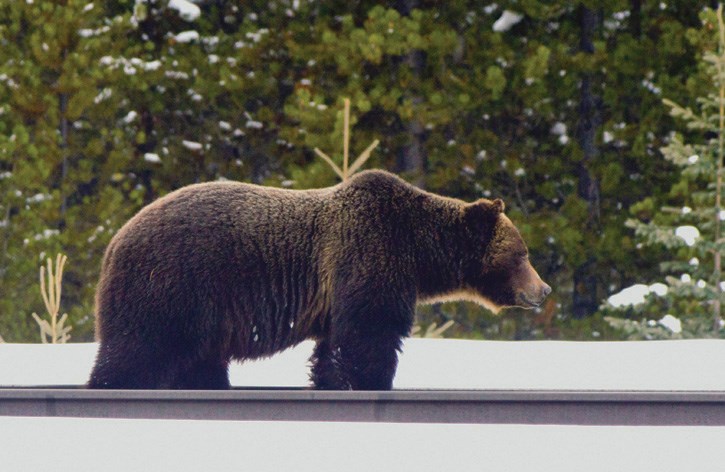BANFF – The Bow Valley’s most dominant male grizzly bear was forced off the train tracks near Banff last week amid fears he would be struck by a train again.
Bear No. 122, also known as the Boss, was feeding on a pile of grain on Oct. 23 when Canadian Pacific Railway alerted Parks Canada.
Resource conservation officers were quick to the scene to haze the grizzly, yelling and firing bear bangers to scare him away from the area. CP later brought in the vacuum truck to clean up the grain pile.
“He was fairly motivated to stay because there was a source of grain. It was a pile of grain, not like a long trickle,” said Bill Hunt, Banff’s resource conservation manager for Banff National Park.
“It’s a reminder that we still have a grain problem that we’re dealing with. We work closely with CP to detect bears, and if we do see bears on the tracks to get out there to prevent bears being struck or dying.”
The 18-year-old bruin miraculously survived one train strike in 2010 near Vermilion Lakes, but 17 other grizzly bears since 2000 haven’t been so lucky – a significant blow to Banff’s population of about 60 grizzles.
In fact, train strikes are the leading cause of death of the threatened species in this area.
They’re threatened in Alberta because of their low reproductive rates, low population sizes, long time between breeding and high rates of human-caused mortality.
While bear No. 122’s movements in the park vary throughout the season, the railway is a major travel route for him.
Hunt said bear No. 122 hits the railway hard in search of grain and animal carcasses when he first comes out of hibernation in spring, and again in fall when natural foods like buffaloberries are long gone.
“He seems to find other food sour es when available, but when things get lean, any potential food source at this time of year is really important,” said Hunt.
A $1 million Parks Canada-Canadian Pacific Railway joint action study from 2012-2017 looked at ways to reduce bear mortality on the train tracks, and in particular grizzly bear deaths.
Researchers found several factors were responsible for attracting bears to the railway, such as high protein foods like elk and deer carcasses as well as vegetation.
But it also confirmed that grain is attracting bears too. Researchers found 110 tonnes of grain are being deposited in the park – enough to feed about 50 bears for an entire year.
Canadian Pacific Railway officials said they continue to communicate with Parks Canada regularly regarding wildlife and railways.
They said the result of the $1 million joint CP-Parks Canada study confirmed “there is no easy solution” to prevent bear deaths on the train tracks.
Salem Woodrow, CP’s spokesperson, said the research done has provided all parties science-based mitigation measures to investigate further and implement.
“CP has almost completed its second year of a three-year escape path widening project, allowing wildlife more space to move away from oncoming trains,” she said.
While no grizzly bears have died on the tracks this year, two adult male black bears were killed in mid-May – one by Baker Creek near Lake Louise and the other near the water tower by the Trans-Canada Highway east of Banff.
Hunt said he’s thankful no grizzlies have died on the railway in recent years.
“It’s good news,” he said.
Parks Canada asks that all bear sightings be reported to dispatch at 403-762-1470.




